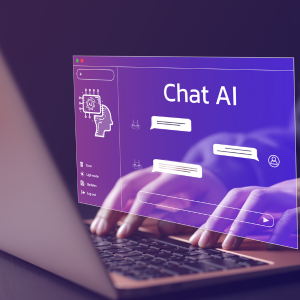
One of the many benefits promised by artificial intelligence (AI) evangelists is that generative AI will reduce or eliminate repetitive tasks. Given that large language models (LLM) such as ChatGPT can “learn” to process and output information in a desired format, any task that requires written input can be completed with a simple request. One of the most popular examples of this is during the job application process, in particular the creation of resumes, cover letters, and other forms of personal marketing. Naturally, the response to this development has been mixed, as some view the output of these tools as inherently misrepresentative of the applicants.
As AI becomes more widely adopted and more sophisticated, it is important that your human resources (HR) team has a solid understanding of how it works, how to recognize AI-generated content, and what the implications are to your hiring process. This doesn’t necessarily mean disqualifying candidates who utilize AI, nor does it mean seeking out foolproof tools for detecting it. Rather, these new tools are an invitation to HR teams to take a closer look at how they source, identify, attract, and ultimately hire qualified candidates. Here are some of the ways you can assess and account for AI in hiring:
Ask what hiring was like before AI
The best way to start is to examine the state of hiring before AI. Although a huge amount of attention is being paid to AI tools currently, it’s worth noting that automation was already a significant part of hiring well before LLMs became a popular tool. Applicant tracking systems (ATS) offered automated resume screening over a decade ago, parsing huge amounts of resumes and cover letters for keywords and giving recruiters a list of the top candidates.
This is relevant because it is part of why candidates are now using automation — hiring was already a difficult process of sorting through hundreds or even thousands of applicants. This incentivizes both recruiters AND applicants to find ways to streamline and speed up their process. This should give you insight into why these tools are attractive, and that they don’t speak to a candidate being lazy or unmotivated for the job — they are simply finding a way to be more efficient in the context of an arduous hiring process.
Learn about the fundamentals of LLMs/AI
These tools, though sophisticated, are not infallible, and you can learn to identify evidence of AI usage. Some of the more common hints are the repetition of keywords or phrases found in the job description, as some tools utilize job descriptions as data inputs before outputting a resume. You may also come across a certain phrase or sentence over and over in different resumes, which is possible evidence. Since these tools calibrate based on success, if certain phrases seem to work, they are incentivized to include them as much as possible. You can even look these up using a plagiarism checker. Some AI tools tend to favor highlighting hard skills and experience over soft skills like leadership or teamwork, which can be a giveaway and also make the candidate seem less well-rounded.
Discuss the pros and cons of AI usage
This discussion should include the internal usage of automation as well as the ways that candidates use it. While the prospect of candidates using AI for resumes and cover letters does mean they are less focused on individual roles, that does not necessarily mean they are unqualified or a bad candidate. You can explore the ways that things like a resume or cover letter can be deemphasized or used as a jumping-off point for more in-depth discussions with candidates. According to ResumeBuilder, nearly half of applicants use ChatGPT for resumes, which means it isn’t something that can be ignored.
Internally, you can also discuss the benefits and drawbacks of an automated hiring process. Many ATS tools have led to significant problems — issues of discrimination, missing out on highly qualified candidates, and other things. Making good on the promise of AI, if those promises are to be believed, means harnessing the time it saves your team to refocus on areas where you can really learn about candidates, such as interviews, skill assessments, and references. Since these are the steps in the process that cannot be automated, they should be seen as having a greater weight than personal marketing in the form of a resume or cover letter.
Work out a team AI policy
You shouldn’t just base this on conventional wisdom but rather on what works for your organization — for a nonprofit, you may find that a stringent approach to filtering out AI resumes could limit your ability to hire effectively. Conversely, you may find that a filtering process allows you to bring in candidates who are uniquely motivated to join your organization, not just find a job.
You should also consider the ways that you built the team in the past, and how good candidates were located. Investing more in networking, building connections with professionals at other nonprofits or organizations in the same field, or attending job fairs or other similar events can help you reduce dependence on automation. Creating more opportunities for person-to-person interaction, without the intermediary of an algorithm, is a great way to reduce some of the risks posed by impersonal AI-based interactions.
Internally, you can also think about the ways that whatever automation you use could be limiting your recruiting capabilities, and if there is another way to generate a list of quality candidates. You should also think about the values and soft skills that are most critical at your organization, be they leadership, empathy, listening skills, or something else, and come up with ways to assess these during the hiring process.
Meet your hiring goals with 501(c) Services
Our team of nonprofit experts is focused on helping organizations like yours adapt to new tools and changes in the nonprofit landscape. We can help you make the most of new developments like AI while staying true to your core values and to your organization’s mission. If you’d like to learn more about how we can help, reach out to us.
ABOUT US
For more than 40 years, 501(c) Services has been a leader in offering solutions for unemployment costs, claims management, and HR support to nonprofit organizations. Two of our most popular programs are the 501(c) Agencies Trust and 501(c) HR Services. We understand the importance of compliance and accuracy, and we are committed to providing our clients with customized plans that fit their needs.
Contact us today to see if your organization could benefit from our services.
Already working with us and need assistance with an HR or unemployment issue? Contact us here.
(Image by Canva.com)
The information contained in this article is not a substitute for legal advice or counsel and has been pulled from multiple sources.




